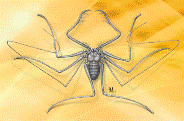Papers in the Biological Sciences

Eileen Hebets Publications
Document Type
Article
Date of this Version
2-2016
Citation
Published in Biology Letters 12: 20150957; doi: 10.1098/rsbl.2015.0957
Abstract
In sexually cannibalistic animals, male fitness is influenced not only by successful mate acquisition and egg fertilization, but also by avoiding being eaten. In the cannibalistic nursery web spider, Pisaurina mira, the legs of mature males are longer in relation to their body size than those of females, and males use these legs to aid in wrapping a female’s legs with silk prior to and during copulation. We hypothesized that elongated male legs and silk wrapping provide benefits to males, in part through a reduced likelihood of sexual cannibalism. To test this, we paired females of random size with males from one of two treatment groups—those capable of silk wrapping versus those incapable of silk wrapping. We found that males with relatively longer legs and larger body size were more likely to mate and were less likely to be cannibalized prior to copulation. Regardless of relative size, males capable of silk wrapping were less likely to be cannibalized during or following copulation and had more opportunities for sperm transfer (i.e. pedipalpal insertions). Our results suggest that male size and copulatory silk wrapping are sexually selected traits benefiting male reproductive success.
Includes Supplementary Materials: Methods, Tables S1 & S2, and Figure S1. Data is attached (below) as a spreadsheet file. Video link is https://youtu.be/0CpVcjT4URw
Spreadsheet data
Included in
Animal Sciences Commons, Behavior and Ethology Commons, Entomology Commons, Evolution Commons, Other Ecology and Evolutionary Biology Commons


Comments
Copyright © 2016 Alissa G. Anderson and Eileen A. Hebets. Published by the Royal Society. Used by permission.